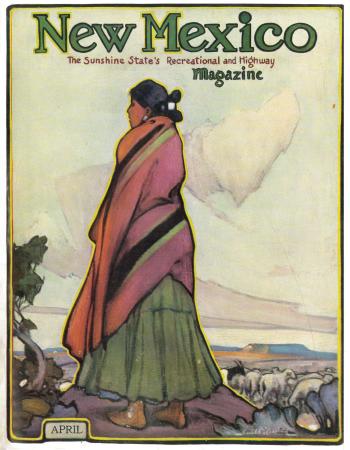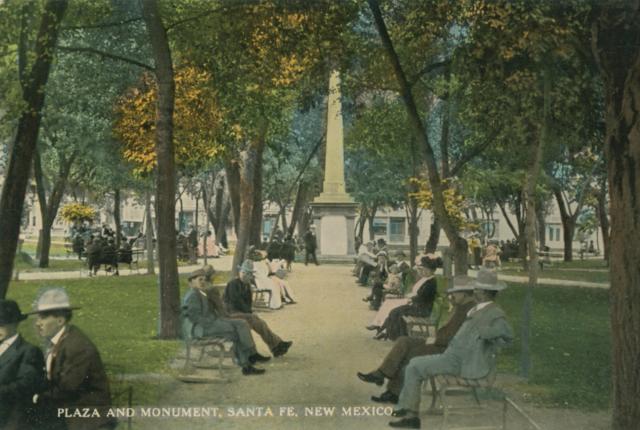GROWING UP IN ALBUQUERQUE, I heard a lot of stories about New Mexico. Some were about brujas, or witches, and others were about Los Hermanos Penitentes. Indita songs told of cautivas (Indian captives) and ciboleros (buffalo hunters). When my late father was growing up in Mora’s high mountain valley, his mother warned, “Hay muchas brujas en Mora” (“There are many witches here in Mora”).
Those ideas were passed on to me and my siblings, along with tales of conflict between Apache warriors and the area’s Hispano residents. Our great-great-grandfather Felipe Lovato and the other men of the Mora Valley confronted and clashed with other Native people over who would have access to that ancient mountain pass. These unfolding stories our elders gave us resonate and reveal a fascinating and complex historical past.
New Mexico history, like our land and people, is at once beautiful, mysterious, intoxicating, and sobering. The ancient remnants at Chaco Culture National Historical Park remind us that it was a thriving civilization at one time. The haunting emptiness also emphasizes that something catastrophic and life-changing happened that caused the Ancestral Puebloans to scatter and establish new communities along what is now the Río Grande watershed. New Mexico became the land of the pueblos.

ON THE COVER
April 1934
Gerald Cassidy’s The Navajo Shepherdess is one of our most iconic covers. It also graced the July 1997 issue.
Spanish civilization arrived in New Mexico in a dust storm of armor, horses, cattle, and diverse humanity from far-off lands such as Spain and the Valley of Mexico. Rooted in the Latin language of conquest imported to the Iberian Peninsula by Romans 1,700 years earlier, Spanish became a lingua franca in New Mexico and, along with the quipu and other Puebloan cultural tools, assisted in uniting the pueblos against the Spanish in 1680 when revolt erupted. After the Spaniards returned with a new attitude in the 1690s, the subsequent century witnessed a blending of Spanish (Catholic, Jewish, and Muslim), Portuguese, French, Mexican, Puebloan, Genízaro, Navajo (Diné), Apache, Comanche, Ute, and Kiowa peoples and cultures into a unique New Mexico society that, by 1800, had become something quite extraordinary: nuevomexicano culture. Such diverse cultures and perspectives are essential to what makes this state so special.
In the mid-1800s, American settlers, businessmen, and opportunists ushered in more change, altering the political and demographic landscape of New Mexico, sometimes legally, other times violently. The Lincoln County Wars of the 1870s are illustrative. U.S. conquest and colonization brought technological innovations, such as the railroad, and democracy replaced monarchy and empire. The radical shift into statehood in 1912, and then the thrusting of New Mexico into the center of world events in the 1940s with the Manhattan Project at Los Alamos, only strengthened New Mexico’s duality, with one foot planted firmly in the past and the other in the uncertain future.
While there is a natural temptation to cling to the heroic and perhaps mythic aspects of our past, the truth is much more compelling. New Mexico is a land that was invaded, conquered, and changed by different cultures and peoples throughout the centuries. Conquest, invasion, and colonization have shaped our collective psyche. Assimilation has been attempted through missions, boarding schools, and other means and institutions. Yet the old ways persist.
We must talk about our history—whether one is for or against the Pueblo Revolt of 1680, or for or against the atomic bomb detonation at the Trinity Site in 1945. Conversations may be heated, but they are necessary, for it is through our history that we learn about ourselves and one another.
Whether 50, 100, or 500 years ago, historical events often seem as if they happened only yesterday. New Mexicans speak about their history with a fiery passion that might lead one to think those things happened to them, not earlier generations. Ours is a very intimate relationship with the past and with our ancestors. We are the land of mañana, the land of tomorrow, and, filtered through the lens of history, we become the land of ayer, the land of yesterday. History, direct and raw, is very much present in New Mexico.
Read more: For this author and historian, New Mexico’s back roads always lead to untold rewards.
A 14th-generation New Mexican, Rob Martínez is the state historian. He can be found onstage throughout the central/northern Río Grande Valley performing New Mexican Hispano music, as well as acoustic pop and Beatles songs.
OUR SPORTS HEROES RACED INTO HISTORY
“When it comes to sports, the Unser family put New Mexico on the map. Bobby and Al Unser grew up on Route 66, at their dad’s Chevron station, when Route 66 was dirt. We need to always remember what they were able to accomplish out of Jerry Unser’s garage. A family with nine Indy 500 victories is just improbable and a great story. If you grew up in Albuquerque, especially in the era that I did, those are your heroes. And they always will be. The legacy they left is tremendous.”
—Carlos Garcia, curator of the neon sign graveyard at the new West Central Route 66 Visitor Center




